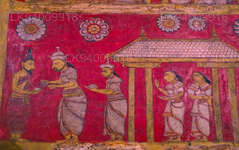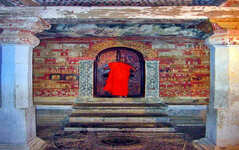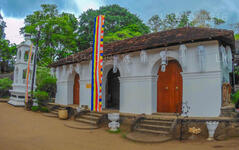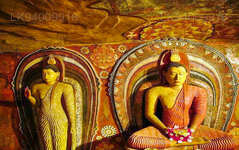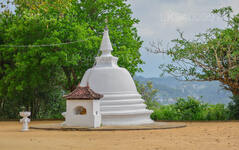
Kandy City
Kandy, en malerisk by i det centrale Sri Lanka, er kendt for sin rige kulturarv, livlige festivaler og smukke natur. Beliggende midt i frodige bakker, er den hjemsted for Tandtemplet, der er på UNESCOs verdensarvsliste, og byder på en betagende blanding af historie og naturlig pragt.
Degaldoruwa Raja Maha Vihara
Amongst the rocky slopes and green valleys of rural Kandy lies a hidden treasure; the Degaldoruwa Raja Maha Vihara. This temple awes those who view it with its incredible Kandyan era frescoes. Construction of the temple began in the late 1770s under the reign of King Kirti Sri Rajasinha and was completed under the reign of his brother Rajadhi Rajasinha years later.
Legend
According to folklore a farmer was exploring the area and found a crevice between two rocks. On venturing into space he found a cave with a pile of golden sickles. The farmer was delighted with his discovery but feared retribution from some strange power. So he simply took only one sickle every morning and, after using it in his fields, returned it in the evening. His fields yielded an extremely healthy harvest and the farmer attributed it to the golden sickle. But then he became greedy. After all, he had been taking the sickles every day and there had been no ill effects, and there was a whole pile of them. So on the very last day of the harvest, he took two sickles instead of one and did not return one of them.
But unknown to the farmer, there had indeed been a guardian for the treasure. The guardian noticed the farmer taking the sickles, but kept quiet as he always returned them. On the day that the farmer took one sickle for himself, the guardian saw it at once and confronted him in his home. The terrified farmer immediately rushed to the crevice and returned the golden sickle that he had stolen. The guardian, who had been disappointed, then sealed the crevice by fusing the two rocks together. However, the villagers got to know this story and informed the king, Kirti Sri Rajasinha; who then ordered that the cave be found and a temple erected in it.
The Structure
- The temple is hollowed out of a 40 foot rock outcrop extending a natural cave. It consists of an elegant rock shelter with two roofed antechambers in front; a drummers’ hall and an image house; and the main shrine room cut into the rock itself. The two antechambers are constructed outside the rock outcrop and have wooden roofs.
- The architecture is unusual for the period as the drummers’ hall is not usually attached to the main temple.
- The image house is located through a set of old wooden doors, situated under a carved wooden Dragon Arch. It preserves a moonstone and a sequence of elaborate and colorful paintings showing scenes from four Jātaka tales, which tell the stories of the previous lives of Buddha.
- The door of the shrine room is banded with metal and once had jewels embedded within it. The inner walls of the shrine are completely covered in paintings; including the door.
- In addition to this main structure, there is a bo tree and a stupa on a plateau on the summit of the rocky outcrop above the temple. They can be reached by stairs carved into the temple.
The Frescoes
The paintings of Degaldoruwa, which are supposed to be some of the best of the Kandyan era, are believed to be the work of four ‘Sittara’ artists. The finest of these paintings grace the ceiling of the temple; ‘Mara Yudde’, an artistic depiction of Buddha’s internal spiritual battle against Māra, the demon of death, rebirth, and desire.
The murals are unique in that all the elements; the people, the trees and the animals; are a uniform size and only the front views of ]people are shown. The trees have a stylized form, with their branches and leave spreading out to either side. The individual elements, such as the adornments on the elephants and the uniforms of the attendants, are portrayed in great detail. All of the colors used by the artists in the murals were created from the barks
Om Kandy-distriktet
Kandy-distriktet ligger i den centrale provins i Sri Lanka. Kandy er et af Sri Lankas syv verdensarvssteder og var engang hjemsted for Kandy-kongerne i det 16. århundrede og en kilde til al musik, kunst, håndværk og kultur i landet. Omkring 129 km fra Colombo ligger Kandy i et bakket terræn, og alles øjne drages mod byens centrum, hvor Kandy-søen danner et charmerende element. Kandy har fortsat stor religiøs betydning for Sri Lanka, fordi det er i denne charmerende by, at Dalada Maligawa eller "Tandtemplet" ligger, hvor Buddhas hellige tandrelikvie ligger velbevogtet.
Den Kongelige Botaniske Have i Peradeniya ligger omkring 5 km vest for bymidten i Peradeniya og besøges af 1,2 millioner mennesker om året. Det er den største botaniske have på øen. Udawatta Kele (Udawatta-skoven) er et beskyttet reservat beliggende i hjertet af byen, lige nord for Tandtemplet.
Kandy er en by med et flertal af singalesere; der er betydelige samfund, der tilhører andre etniske grupper, såsom maurere og tamiler. Kandy er kun overgået af Colombo, centrum for Sri Lankas økonomi. Mange store kooperativer har store filialer i Kandy, og mange industrier, herunder tekstiler, møbler, informationsteknologi og smykker, findes her. Mange landbrugsforskningscentre er placeret i byen.
Og et springvand for al musik, kunst, kunsthåndværk og kultur i landet. Omkring 129 km fra Colombo ligger Kandy i et bakket terræn, og alles øjne drages mod byens centrum, hvor Kandy-søen danner et charmerende træk. Kandy har fortsat stor religiøs betydning for Sri Lanka, fordi det er i denne charmerende by, at Dalada Maligawa eller Tandtemplet ligger, hvor Buddhas hellige tandrelikvie ligger velbevaret.
Om Centralprovinsen
Den centrale provins i Sri Lanka består primært af bjergrigt terræn. Provinsen har et areal på 5.674 km² og en befolkning på 2.421.148. Nogle større byer inkluderer Kandy, Gampola (24.730), Nuwara Eliya og Bandarawela. Befolkningen er en blanding af singalesere, tamiler og maurere.
Både bjerghovedstaden Kandy og byen Nuwara Eliya ligger i Centralprovinsen, såvel som Sri Pada. Provinsen producerer en stor del af den berømte Ceylon-te, som blev plantet af briterne i 1860'erne, efter at en ødelæggende sygdom havde dræbt alle kaffeplantagerne i provinsen. Centralprovinsen tiltrækker mange turister med bjergbyer som Kandy, Gampola, Hatton og Nuwara Eliya. Tempeltand eller Dalada maligawa er det vigtigste hellige sted i Centrel-provinsen.
Klimaet er køligt, og mange områder omkring 1500 meter har ofte kølige nætter. De vestlige skråninger er meget våde, nogle steder med næsten 7000 mm regn om året. De østlige skråninger er dele af den midterste tørre zone, da den kun modtager regn fra den nordøstlige monsun. Temperaturerne varierer fra 24°C i Kandy til kun 16°C i Nuwara Eliya, som ligger 1.889 m over havets overflade. De højeste bjerge i Sri Lanka ligger i Centralprovinsen. Terrænet er for det meste bjergrigt med dybe dale, der skærer sig ind i det. De to vigtigste bjergregioner er det centrale massiv og Knuckles-bjergkæden øst for Kandy.


